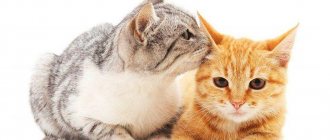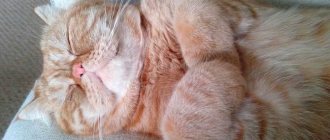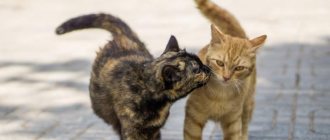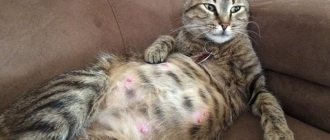Some habits are quite natural behavior after mating, although they may cause some surprise from a human point of view. But others may indicate a developing disease. Let's consider the question in more detail.
Why does a cat still “flow” after mating?
In fact, everything is natural and natural. Usually, for several hours and even days after coitus, the female will behave restlessly, still purring, rolling on the floor and lifting her tail when any touch to the rump.
The phenomenon is explained simply: during estrus, a huge amount of sex hormones are released into the blood, and it takes some time for the body to adjust to its normal mode. Ovulation occurs somewhere 24-36 hours after intercourse, it is quite logical that the animal will still be in heat for at least a day and then it will take another 2-3 days for all the accompanying symptoms to subside.
In such cases, they focus on the cat’s behavior. If he has lost all interest in the imported bride, then ovulation has occurred and the expectant mother can safely be taken home.
Sometimes, even after successful fertilization, the female experiences repeated estrus (superfetation) and again asks for a cat. The phenomenon is associated with decreased progesterone levels during the current pregnancy. Under no circumstances should repeated mating be allowed, especially if 2 months (65-70 days) have not yet passed since the previous one, otherwise there will be two batches of embryos of different ages in the uterus at once. There are two possible developments:
- timely birth, while the younger litter dies;
- the cat first gives birth to the first litter, and a few weeks later the second.
Choosing the time period of estrus
Estrus can occur in a hidden form, and the cat will begin to furiously ask for a male cat already on the 4th day. It is important not to make a mistake with the time interval of estrus
The next step is timing during estrus . The cat cannot become pregnant for the first 2 days. It is better to send her to the cat on the 3rd day and leave her for 3 days. The process of ovulation in cats begins after reaching a certain concentration of hormones in the body. One or 2 days of mating is not enough to pump up a certain level of hormones.
Sexual viability
The ability to reproduce in representatives of the cat family is called sexual maturity. Females reach this state by 6-8 months, males - 4-5 weeks later. The sexual hunt begins: “girls” go into heat, and “boys” have an increase in testosterone levels, which is manifested by increased aggression and marking of territory.
However, the time has not yet come for the first mating at such a “tender” age. Risk factors for premature mating include:
- slower growth and development;
- deterioration in appearance;
- complications of pregnancy and childbirth;
- the birth of weak or stillborn babies;
- the threat of infertility (for “girls”) and impotence (for “boys”).
For romantic dates, you need to wait for structural formation, physiological and psychological maturity. The optimal age of a cat for the first mating is 14-15 months. At this point, Murka is going through 2-3 heats.
It’s also not worth delaying fertilization. You can’t let your pussy stay “in the girls” for too long. Owners who delay untying their pet for up to one and a half years should be aware of the possible consequences for its health:
- polycystic disease;
- inflammation of the uterus;
- false pregnancies;
- stress;
- exhaustion.
“Grooms” are physiologically ready to perform reproductive functions at the age of 12-13 months.
Symptoms of the onset of labor
Early warning signs of childbirth are sagging of the abdomen as a result of relaxation of the ligaments, as well as retraction of the sacral region.
On the eve of delivery, swelling of the genital organs and mammary glands occurs, and droplets of colostrum are released. Viscous mucus without pathological impurities comes out of the loop.
When labor occurs, the water breaks, releasing a grayish-pink fluid. Then contractions appear, which normally last for an hour, which, if the outcome is favorable, end with the birth of offspring.
After mating, the cat vomits, diarrhea, does she have a fever?
Such symptoms, although quite rare, do occur. Why is this happening?
- Consequences of stress: change of environment, rampant hormones, etc.
- Stomach upset as a result of a sudden change in food, if the owners of the female for some reason forgot to transfer the usual food to the temporary place of residence.
- Food poisoning, poisoning, which are in no way related to cages, but are a coincidence of two phenomena in time.
Very rarely, if cat owners are negligent about vaccination, a cat can pick up a pathogenic virus in someone else’s home. There have been cases when, after mating, a female became infected with calcivirosis, rhinotracheitis, panleukopenia, rhintotracheitis, etc.
That is why it is so important to check the breeder’s veterinary passport before mating and inquire about the vaccinations given. Even a healthy-looking cat, which is full of strength and energy, can turn out to be an “incubator” (a carrier of the virus) and transmit a terrible and dangerous disease to its lover. By the way, cat owners should also not forget about preventive vaccination.
Solving problem situations
In the affairs of amorous animals, not everything goes smoothly. In some cases, a couple needs help from:
- The cat hisses at the cat when mating. There is no need to rush animals, especially inexperienced ones. They need more time for foreplay.
- The cat is smaller in size than its partner, as a result of which the cat rests on its back. In this case, it is necessary to send the male.
- The bride falls on her side during sexual intercourse. In such a situation, they support the female.
We suggest you read: What to feed a castrated cat with natural food. Feeding a cat after castration: features of natural and industrial nutrition
Demonstration of trust
A satisfied and calm cat in its territory playfully rolls from side to side, gracefully stretches out and squints its eyes. At the same time, her muzzle radiates bliss and serenity - this is how an animal invites a familiar person to careful caresses and gentle stroking.
A sign of friendship and goodwill towards a person or fellow tribesman for a cat lying on its back is the stretching of its front paws with soft pads.
False pregnancy after mating
False pregnancy is harmful to the cat. Unlike dogs, false pregnancies do not occur as often in cats. Its occurrence is preceded by sterile sexual intercourse, that is, when the reproducer has some problems with the seminal fluid, for example:
- low sperm motility;
- complete absence of “little creatures” due to frequent use or inflammation;
- pathological forms of male cells or their non-viability.
Like a normal pregnancy, a false pregnancy is accompanied by:
- cautious behavior;
- nipple enlargement;
- swelling of milk cartons;
- rounded belly;
- After the due date, the cat “gives birth” and produces milk.
It is clear that imaginary tightness is very harmful for the female: the psyche and general condition of the body suffer, and hormone levels are disrupted.
How to avoid? Before uniting loving hearts, it is necessary to be interested in the male health of the inseminator, the fate of his former partners (in terms of whether they became pregnant or not), and the presence of offspring from other females.
HOW MANY KITTENS CAN A CAT GIVE BIRTH AT THE FIRST TIME?
On average, a cat will give birth to 1-6 kittens per litter, and this can depend on various factors. This is often influenced by the characteristics of the body, and even more often by the state of health of the animal. Cats have a bicornuate uterus, the horns of which contain fertilized eggs at the beginning of pregnancy. They attach to the walls of the uterus.
Since “space” is limited, more than 6 kittens are very rarely born in one litter.
The first birth is different in that during it cats give birth to no more than 3 kittens.
We will learn about the character of a British cat, discuss its features. We will tell you how long pregnancy lasts in cats: and find out the details.
By the way, the same feature is found in old cats. In general, in old age, these animals rarely give birth, but they can love other people’s kittens like mothers and even “adopt” them.
A sterilized cat asks for a cat: 4 reasons
There are the following causes of estrus in sterilized females:
- Incomplete removal of epididymal tissue. Occurs when an unremoved piece of ovarian or epididymal tissue remains, which is capable of regenerating and partially replacing the internal secretion organ. Estrus occurs as usual, but pregnancy does not occur and the pet will not be able to bring kittens. Repeated surgery, as a rule, does not solve the problem. Not every veterinarian is able to find the criminal piece of tissue, and repeated anesthesia will harm the cat’s health. However, the chance of achieving a positive result increases if the uterus and surrounding tissue are removed.
- Development of the reminant ovary. After the removal of the reproductive organs, the pituitary gland or adrenal glands begin to produce sex hormones. Statistics show that one out of seven castrated cats can retain the ability to secrete estrogen.
- Congenital anomaly. Cells of the ovarian appendages take root in other organs.
- Development of a hormone-like tumor. The neoplasm has the ability to secrete estrogens. Pathology is observed in cats that were castrated in adulthood.
Be sure to read: How to care for a cat after sterilization: blanket, diet, treatment and removal of sutures
Sterilization and ovariohysterectomy
Nowadays, sterilization is used extremely rarely, since ligation of the fallopian tubes does not inhibit sexual desire and does not guarantee protection against pathological inflammation of the uterus. A more reliable operation is ovariohysterectomy - removal of the uterus and ovaries at the same time.
The time for sterilization is outside the heat period, two weeks before or after the onset of estrus.
Should there be discharge after mating?
This is where it’s worth going into more detail. The fact is that discharge from the genitals after mating in cats is normal in some cases, but in others it is a very serious signal that there is a pathology in the body.
Usually, another 2-3 days after the cage, you can observe transparent, watery mucus - this is the norm and the result of a still ongoing estrus. This phenomenon should not bother owners.
But the appearance of dirty, brown, viscous discharge mixed with blood and an unpleasant odor is a very bad and unfavorable symptom. What it could mean:
- abortion;
- sexual infection;
- inflammatory processes in the reproductive organs (gynecological diseases).
Abortion can occur at longer periods or just a few days after mating. He can wear:
- infectious etiology, the same sexually transmitted infections (brucellosis, chlamydia, toxoplasmosis, plague);
- and non-contagious, when there are abnormalities of intrauterine development, endocrine disorders (reduced secretion of progesterone), intoxication, the use of drugs that affect the functioning of smooth muscles, various injuries or hypothermia.
With different types of abortion there will be different signs. You can indirectly judge an impending miscarriage by the appearance of dark green discharge mixed with blood. In any case, consultation with a specialist and pelvic ultrasound are necessary to make a diagnosis.
Gynecological diseases arise as a result of the influence of various factors, in particular secondary microflora. Opportunistic microorganisms present both on the male penis and in the female vagina are the cause of opportunistic infections that lead to inflammatory processes in the reproductive organs.
For a healthy animal, the presence of these microbes does not pose any danger. If a cat has microtraumas on the reproductive organs, immunity is reduced, then the natural defense weakens, “foreign” bacteria transmitted by the cat during sexual intercourse begin to multiply rapidly, leading to diseases such as vaginitis, metritis, pyometra, endometritis, oophoritis and etc.
In most cases, gynecological diseases are accompanied by discharge and subsequent pregnancy failure, if it occurs at all. Therefore, it is so important to carry out periodic examinations before mating, to treat the animal in a timely manner for any inflammation, in order to be confident in the health of the pet and her ability to bear healthy offspring.
Mating process
When a cat goes into heat, her behavior undergoes changes. She demonstrates her readiness for mating in the form of loud meowing, rolling on the floor, lifting her tail to the side, and arching her back. She takes the same body position during intercourse. The cat settles on top, clinging to the withers with its teeth. The paws are located on the sides.
Classic position during mating
It all starts with foreplay. The cat approaches the female, sniffs her and purrs gently. Most cats at this moment drive the cats away, hissing and waving their paws. The male retreats, but not for long. Then the attempt is turned again. And so on until the cat agrees to mating.
The sexual contact itself lasts 15-25 seconds. During the ejaculation process, the cat makes a loud sound. This is explained by the presence of spines on the penis (to stimulate ovulation). The cat at this time pushes her away from him. The pet may show aggression towards its lover. Therefore, he must quickly run away and hide.
Next, the female will begin to actively roll around on the floor, then will lick the genital area. Some cats are not ready for secondary intercourse. It is possible to repeat sexual contact only after 3-7 attempts. There can be a lot of matings. Therefore, there is no point in doubting that the cat will become a mother in 9 weeks (if the groom’s reproductive organs are fine).
How to prepare for the birth of a cat can be read in our article.
The first thing the cat will do is start licking itself.
Ideally, mating is best done on day 3 of the cycle. Here the probability that ovulation will occur is almost 100%. Some people practice mating within 3 days of the start of estrus, which is also quite effective.
Cat behavior after mating
It’s worth saying right away that mating is a very energy-consuming process for a cat. Several days of loud meowing, lying on the floor, multiple sexual contacts can leave their mark on the female’s well-being.
Therefore, the animal may feel tired, hide in a corner, crawl under the sofa and simply sleep quietly for several days. If the pet comes out of the “nest”, drinks water, eats, and goes to the litter box, then everything is fine, there should be no reason for concern.
The cat is clearly tired after mating
An increased appetite in a furry pet is also considered normal. During mating, the animal loses a lot of calories and energy, which it tries to replenish by feeding on a bowl of food. Some veterinarians believe that in this way a responsible cat accumulates strength for bearing offspring and subsequent births.
You should not mate a cat with a male at the very beginning of estrus (proestrus). She simply won’t let him near him and may scare him away.
Some pets continue to demand a cat even after numerous sexual intercourses. This process is also easy to explain. It all depends on what day of estrus the intercourse occurred. The fact is that the number of hormones fluctuates throughout the entire period of estrus. Accordingly, the animal’s behavior will change. On average, estrus lasts about 5-10 days. These standards are approximate. The duration may be longer, or it may be shorter.
If sexual intercourse occurred in the first days (from the third to the fifth day of the cycle), then the estrus will last the prescribed amount of time. The body does not perceive pregnancy immediately after fertilization. Therefore, some cats behave at this time as if conception had not occurred and continue to demand a cat for mating.
The cat is still asking for a cat
The owner should not allow the breeding to happen again. This can lead to the fact that fetuses with different dates are fixed in the uterine cavity, which will cause the birth of dead kittens or with developmental abnormalities. For mom, this is also a dangerous process, sometimes leading to exhaustion and other dangerous consequences.
If sexual contact occurs in the middle of the estrus period (5-7 days), then there is a high probability that the pet will calm down and stop demanding a cat. Concern on her part will manifest itself if the duration of estrus is more than 10 days. But the activity will not be the same as in the first days.
You should not immediately remove the cat from the carrier. Let the animal sit there for a while and get used to its surroundings.
If intimacy occurred in the last days of estrus, then the cat will behave calmly. In the last days of estrus, the animal's hormonal levels stabilize. Therefore, 90% of all cats stop being active and demanding a male.
If after mating the cat continues to leak?
After mating, the female may continue to worry for a couple of hours (or even days!), scream, stick out her tail when touching her rump, and lie on the floor. This is a natural process and should not cause concern to owners. The fact is that during the process of estrus, a large amount of sex hormones is released into the bloodstream.
Ovulation begins approximately on the second day (up to 30 hours) after mating. Therefore, it is quite reasonable that the cat will demand a cat for at least 1 more day.
The cat does not yet understand that she is pregnant and continues to roll on the floor
How to understand that ovulation has occurred? Everything is very simple. If the cat is no longer interested in the imported bride, this means that the process of release of the mature egg from the ovaries has occurred and the pet can be safely taken home. The same applies to the aggressive behavior of a cat towards a former lover.
The cat is aggressive against the cat
It is worth noting that the female can demand a “groom” during pregnancy. This process is due to the fact that the level of progesterone in the blood decreases sharply due to pregnancy. Pathological hormonal disruption occurs 3-6 weeks from the day of fertilization. The cat does not realize that she is pregnant, so she will demand to finish the job she started. Coitus should not be allowed during this period. Especially if 60-75 days have not passed since the date of mating.
After mating, the cat secretes mucus from the vagina: is it normal or not?
It is worth saying that mucus released from the vagina after mating is in some cases a normal phenomenon, and in others it is pathological.
Usually, within 2-3 days after intercourse, the cat begins to leak a transparent, viscous secretion. This indicates that the heat is continuing. This process should not cause concern to owners.
You need to sound the alarm when the secreted mucus is red, brown or brown in color and emits a putrid odor. It means:
- inflammation in the genital area due to the development of a bacterial or viral infection;
- miscarriage;
- relapse of chronic diseases of the reproductive organs.
The mating clearly went wrong
Abortion can occur 2-5 days after mating or in the last stages of pregnancy. The reasons may be:
- infectious diseases (plague, chlamydia, toxoplasmosis, brucellosis, etc.);
- non-infectious factors - abnormalities in fetal development, endocrine diseases of the mother, injuries, intoxication, taking drugs that affect the functioning of smooth muscles, hypothermia, overheating, etc.
If cloudy and foul-smelling discharge mixed with blood appears, you should immediately visit a veterinarian.
At the veterinarian's appointment
The causes of the infectious process may be foreign microorganisms present on the cat’s reproductive organ or in the cat’s vagina. The inflammatory process starts when the animal’s immunity is weakened, or there are microcracks on the walls of the vagina. Poor functioning of the body's protective functions leads to increased proliferation of bacteria, which causes the development of endometritis, vaginitis, oophoritis, metritis, etc.
In most cases, infectious diseases lead to miscarriage. Therefore, it is very important, even at the stage of pregnancy planning, to take the cat to the veterinarian and carry out all the necessary tests for the presence of infections.
A caring owner decided to take his pet to the veterinarian
False pregnancy after mating
In cats, unlike their barking cousins, false pregnancies are rare, but they do occur. The reasons are:
- lack of motile and healthy sperm in the cat;
- slight mobility of tadpoles;
- diseases of the genital organs of the manufacturer.
False pregnancy, like normal pregnancy, is accompanied by the following symptoms:
- swelling of the nipples;
- the cat begins to be cautious;
- milk cartons increase in size;
- The pet's belly is rounded.
False pregnancy is very similar to true pregnancy
After the required time has passed, the cat gives birth and milk appears. False pregnancy causes serious stress in the cat, mental disorders, and hormonal imbalances.
To avoid false pregnancy, you should ask the owners of the “inseminator” in detail about his health and previous “victories.”
It’s worth asking about any vaccinations you have received. There have been situations when, after mating, males infected cats with dangerous infectious diseases - feline herpes, distemper, calcivirus, etc.
What other cases are there?
The signal that the female is ready for mating is estrus. How do you know if your pussy has started sexual intercourse? She experiences obvious “languor”:
- purrs often and loudly;
- fawns or turns into an aggressive touch-me-not;
- rubs vigorously against all sorts of objects;
- takes a characteristic pose when stroking the back: the trembling tail is pulled to the side, the rear is raised, the chest falls to the floor.
The “lady” is sent to the “gentleman” on the third day after such signs appear. The guest comes with her things: food, bowls, litter tray. No one knows how long it will take to breed a cat and a cat. You need to plan for 1-3 days. The first time it may take a week.
Meeting partners rarely takes place in a warm, friendly atmosphere. Mutual ignoring, hissing, fighting are typical manifestations of cat flirting. The owner of the house should monitor the situation to prevent injury to animals.
When the “lady” gets used to it, she herself begins to flirt with the male. After waiting for the aggression to die down, you need to leave the “newlyweds” face-to-face. How long does a coitus session last? Usually “this” occurs in cats for up to 20 seconds, accompanied by heartbreaking screams. How long after can I visit my clients? It’s worth delicately waiting a couple of minutes for the disturbed duo to calm down.
We suggest you read: Diseases of peacocks and their treatment
How to understand that genital contact has occurred? Silence reigns in the room where the “young” remain. After being untied, Murka's behavior changes dramatically: she becomes tolerant of her partner, lies down next to him, rolls around on the floor, her genitals enlarge and turn red.
How many days does mating last for cats? It all depends on the character and experience of the “newlyweds”. Ambitious murki behave aggressively, shy ones huddle in a corner. The boyfriend must be given time to seduce the “lady”.
In veterinary practice, there are a number of specific cases when the sex hormonal background of a sterilized individual was determined by diseases occurring in the thyroid gland. Aligning and adjusting the balance of hormones in this situation is not an easy task, which may include a number of stages:
- Exclusion of hormone-producing tumors;
- Chemical suppression of sex hormones.
Most often, the latter is performed by implanting a special capsule under the skin.
Important Additions
Some owners are interested in whether there is a danger of “overstaying” the cat if the desired mating with the cat does not take place for too long. Veterinarians advise that a cat’s first experience with a male should occur before she is one and a half years old. Those pets who did not enjoy the joy of motherhood before the age of two may develop difficulties in perceiving themselves and males. Your pet may be aggressive towards cats or afraid of them. In addition, cats that have spent too much time as girls often develop polycystic disease.
You should not give your cat medications that reduce its attraction to the opposite sex. Due to these dubious medications, problems often occur in cats such as bowel disorders, cystic formations in the uterus or ovaries. The fluffy beauty may become infertile, and then the mating of the British that you planned will remain just a dream.
How should a cat behave after mating?
There is no clear answer to this question. Each animal is an individual with its own quirks, temperament, and physical development.
Some cats can hide in a corner and lie there for several days with an indifferent look or just sleep. Perhaps it is stress from experienced emotions or simple fatigue. Screams for many days, endless intercourse make themselves felt, and the body requires rest. If the cat is sad, but otherwise everything is fine: she eats, drinks water, goes to the toilet and does not have a temperature, then there is no reason to worry.
Other ladies have an increased appetite, which in principle is also natural. The answer is still the same: the body restores energy lost during sexual games and accumulates new energy for bearing offspring.
Sex Barrier is the most humane and suitable method for a breeder to calm a pet
As mentioned earlier, it is better for a cat to give birth no more than three times every two years. This will prevent her from being depleted and give her the opportunity to live a full life.
To relieve tension and desire, the Sex Barrier recommended by veterinarians is used. This remedy completely removes all negative manifestations of “desire” in cats.
Its use will provide:
- regulation (delay) of the onset of “hunting” in a cat;
- contraceptive effect (within 24 hours from the time of use);
- decrease in sexual arousal and its negative manifestations: animal screams, “marking” of territory, nervous or angry behavior, the desire to run away from the apartment.
Mating of cats is a sensitive process, and although the sexual act itself lasts no more than a few minutes, the stage of introducing partners and exploring the territory can take a long time. Representatives of the cat world who live on the street differ in this - the search for a male cat suitable for an act of love takes only a few hours.
The cat is limping, crying in pain, won’t sit on its butt – what is this?
First of all, it is necessary to examine the female for bites and deep scratches. Cats, in the heat of passion, grab the bride by the back of her head, neck, and scruff with their teeth, scratching her in order to hold her in place during coitus. This is why all breeders recommend trimming their pets’ nails before breeding in order to somehow minimize injuries.
In the article about mating it was already written that you should not organize a meeting between two virgins, otherwise injuries cannot be avoided. Inexperienced animals can adapt to each other for a long time, the cat does not succeed, but at the same time he is not able to lose his long-awaited sexual partner and holds her by all possible means (teeth and claws).
It is quite possible that the couple was disturbed during boarding, they jerked in surprise, fell off somewhere and the cat could have damaged something.
The problems described above are the most common. If you have any additions or questions, write them in the comments, and your opinion will not go unnoticed.
KotoDigest Thank you for subscribing, check your inbox: you should receive an email asking you to confirm your subscription
Proper conditions for mating
In order for the mating to be successful, the female is brought to the male, but not vice versa. The cat should feel like a master in its area. He definitely needs to mark his territory. And, if the owner prefers to wash off the marks with special solutions that kill odors, then the animal may refuse mating.
Cats need to get used to each other
If, on the contrary, you take the cat to the cat, then he should stay in the house where the “bride” lives for several days. Ideally – 10 days. This period will allow the cat to completely mark the area.
External factors play an important role in mating success. The room where mating is expected must be large so that the animals have the opportunity to play.
First contact requirements
A partner for a meowing ward is found in advance. They look through advertisements, go to exhibitions, prepare their pet for the decisive meeting.
Rules for mating cats:
- To avoid dangerous pathologies, estrus cannot be stopped with hormonal or other drugs.
- The first mating of cats requires a fully completed vaccination plan (4 weeks must pass after the last immunization).
- Half a month before intercourse, deworming is carried out.
- On the day of the meeting, the “bride” (as well as the “groom”) have their claws trimmed to avoid injury.
- It is wrong to bathe cats before mating: soap and shampoos muffle the smell of pheromones.
- At the crucial hour, they make sure that the female is moderately well-fed, well-groomed, with clean ears, clear eyes, and a shiny nose.
Mating a cat and its conditions:
- The breeder is supposed to be healthy, vaccinated, treated for worms, and externally well-groomed.
- To stimulate sexual activity, it is recommended to enrich the menu with B vitamins a couple of days before intimacy.
- The cat owner, as the owner of the “mating station”, is obliged to ensure that the meeting is successful: organize an acquaintance, competently stimulate the development of sexual relations, and be responsible for the comfort and safety of the furry guest.
The meeting of a pair of virgins is undesirable. It is fraught with psychological or physical damage.
Causes for concern
Sometimes owners sound the alarm when a cat, after mating, begins to behave as if she is sick. This is often accompanied by diarrhea or vomiting, and sometimes the temperature rises. There are several explanations for this:
- pronounced reaction to stress (presence of a male or moving, change in hormonal levels, etc.);
- digestive disorders due to a change in diet, if the animal was given to another home for mating without the usual food;
- the onset of toxic infection is possible, which is not associated with attempts to have offspring;
- bacterial or viral infection for which the male has not been vaccinated (calcivirosis, rhinotracheitis, panleukopenia, etc.).










